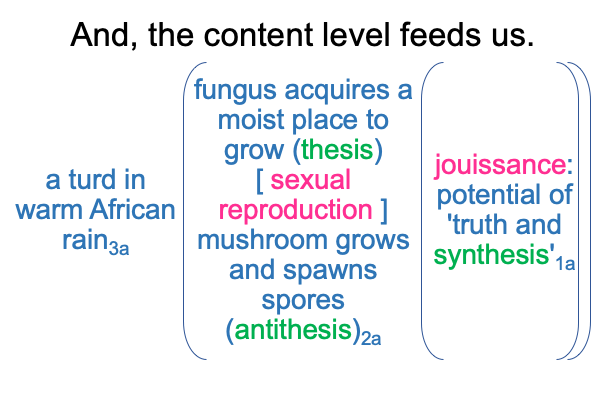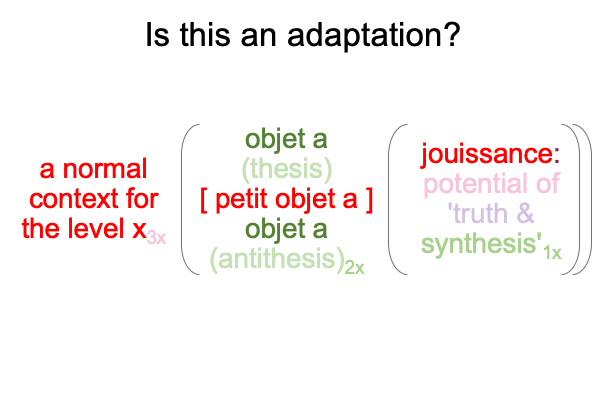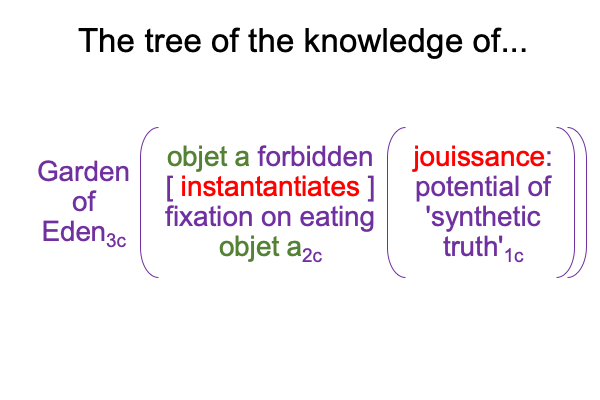0144 Perhaps, the mushroom is not an illusion.
The normal context of a turd in the warm African rain3a brings the actuality of {a place for fungus to grow [sexual reproduction] mushroom grows and spawns spores}2a into relation with a jouissance that hominins learn to anticipate1a. The mushrooms growing around turds are content that inspires a team to initiate collaborative foraging. The hominins recognize that the warm rain inspires the matter of turds on the savannah to form mushrooms. They do not know how. But, the synthesis1a of the following nested form is enough to inspire a team to organize a harvest.

0145 The three levels of [mushroom sexual reproduction]2a, [trade-off]2b and [indirect reciprocity]2c eventually select for specialized cognitive modules after innumerable (although occasional) activations of the mushroom-gathering team3c.
Yes, the natural jouissance of mushrooms1a rewards survival enough that specialized modules evolve that allow hominins to rapidly identify edible mushrooms (as opposed to poisonous), to assess whether the rains are right for mushroom harvest, and to celebrate the joys of munching on mushrooms with family and friends.
They also select for a cultural adaptation: a team that seems to know the ways of mushrooms3c. The team is specialized. Individuals are not. There are no individual specialists. There are only team members who remember what happened in prior excursions and know whether to call the team into action.
0146 This all takes place without speech.
In the Lebenswelt that we evolved in, hominins practice protolinguistic hand-talk, at first in teams (say, 1.8 to 0.6 million years ago), then linguistically in communities (say, 0.6 to 0.2 million years ago) and then with the addition of speech as an adornment (say, 0.2 to 0.008 million years ago). Homo sapiens practices a dual-mode way of talking called “hand-speech talk” for two hundred-thousand years before the first singularity.
Manual-brachial word-gestures of hand talk picture or point to their referents. Word use involves implicit abstraction. Implicit abstraction applies to icons and indexes, two of Peirce’s natural signs. It also operates with symbols, taking advantage of the fact that symbols differ from one another. Remember that Ferdinand de Saussure’s definition of language is two arbitrarily related systems of differences. When icons and indexes become more and more distinct, they become more and more easy to recognize. Easy recognition is a hallmark of symbols.
0147 In contrast, the speech-alone words of our current Lebenswelt allow, even promote, explicit abstraction.
Speech-alone words can label anything and everything.
Labels set the stage for explicit abstraction.
Here is Lacan’s terminology applied to all three of the nested forms depicted above.

This figure almost looks as derivative as the market3b formulation (point 0129).
It applies directly, to the perspective-level of an interscope, less directly, to the situation-level and indirectly, to the content-level.
0148 What does this imply?
Does jouissance1x turn the wheel of desire? Does objet a2x rotate upon the axis of [petit objet a]2x? Does a normal context3x frame the wheel of desire?
Plus, does speech-alone talk play a crucial role in labeling all of these elements, in such a fashion that the entire nested form is no longer an expression of “an adaptation”, in the biological sense of the term.
Yes, the implicit abstraction of the category-based nested form is an adaptation that our ancestors could not image and indicate using hand talk. However, speech-alone talk facilitates explicit abstraction. Every element gets a label. We naturally grant that a manual-brachial word gesture has a referent that precedes the gesture word. After all, hand-talk pictures and points to its referents. What happens when a label precedes its referent and makes it seem that the referentexists independently of its purely relational structure?
0149 A Buddhist may open the Bible to the third chapter of Genesis and laugh.

0150 The normal context of the garden of Eden3c brings the actuality of the dyad {the fruit of the tree of the knowledge of good and evil is forbidden [substance] a fixation on eating the fruit of the tree of the knowledge of good and evil}2cinto relation with the jouissance of Adam and Eve1c, influenced by ‘the various suggestions made by a speaking serpent ‘1c.
Surely, the serpent cannot practice hand or hand-speech talk.
The Buddhist’s chuckle makes jest of Lacan’s terminology.
Objet a is both the command not to do it (as matter) and the fixation to do it (as form).
The [substance] is precisely the ontological realness that the Buddhist strives to transcend.
